This is the long(er) version of the post. If you want to read a shorter version,
you can do so here.
Lead conversion is a pain. Not that I’m saying it, the numbers are. According to Salesforce, 79% of leads never convert and it’s no wonder. 44% of sales people give up after one “no” and an extra 22% after the second (More than Accountants). It’s not looking peachy for marketers either, since 1 in 3 don’t even consider lead closing to be their top priority. Sure, you might say well, it’s not, lead gen should be the priority of a marketer, but what is lead gen without lead closing? Just extra numbers in your CRM.
I don’t even need to tell you that lead conversion is important. Without it, the companies would have no revenue and us marketers would eventually have no jobs. Which is why I was recently invited to speak at Leadoo’s SME Growth Factory in London about how we can convert more leads. The tools below are some of the examples I presented then (thanks again Leadoo for having me, it was great!).
This article references a lot of B2B use cases, though some may be useful for B2C too.
Better than what?
Aiming to increase lead conversion is great, but increase it from what? To what? These are the first 2 questions any marketing or sales leader should ask first, because the first step is to benchmark. Is 10% a good conversion rate? Would 20% be an excellent one? Is 60% even achievable? It all depends on a few factors, such as your resources (people and follow up process), your industry, the source of your leads. But before you can start impacting it, you need to know where you’re starting from.
This assumes you have a good understanding of your data, which usually comes from a CRM, that can help you draw reports and stats. Take a look at:
- Percentage of leads you convert from total leads generated
- Average amount of time necessary to convert a lead
- Average contract amount
Then split it by other factors that may be relevant to you, like industry, lead source, sales rep, etc. For example, what is my conversion rate with manufacturing clients compared to finance ones. Information is good, but too much can be overwhelming, so limit your analysis to that most important to you.
It’s about the journey, not only about the destination
If I’d ask you how would you eat your own vegetables and you’d say you just go and get them from your garden, that would be correct, but also incomplete. Before harvesting them, you’d have to plant them in good soil, water them, tend to them, protect them from bad weather. And as with gardening, lead conversion is an entire process that doesn’t rely just on how convincing your sales pitch is.
It’s about all the steps preliminary to it, including lead generation and lead nurturing. If a lead misunderstood your services, they’re not likely to convert, are they? Or if your follow up process is patchy, it will hurt your closing rates. So, we view lead conversion as a process and optimising it starts early on in the funnel.
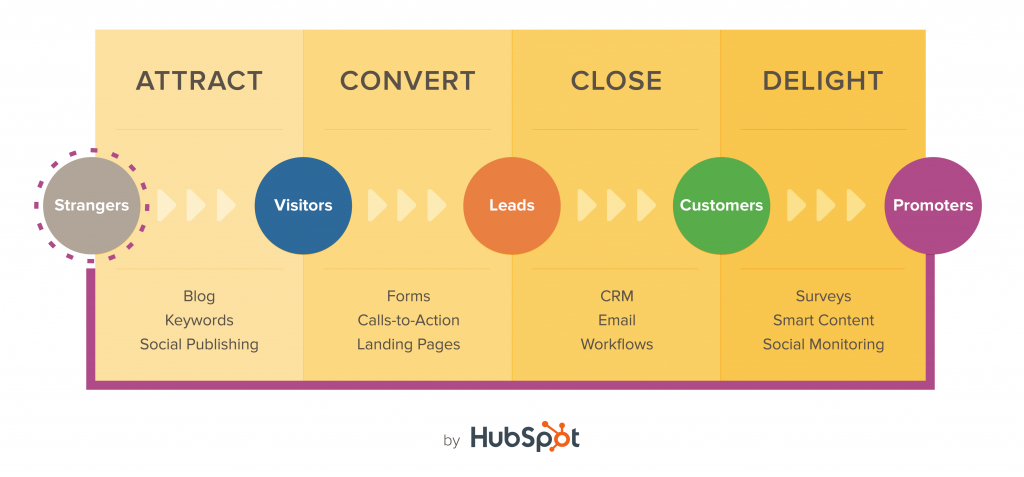
The strategies and tools we’ll be discussing are relevant on all stages of the lead conversion funnel and they are:
- Optimise your website
- Understand your target market
- Gain your audience trust
- Plan the best outreach strategy
- Sell when they’re ready
The examples I’ve chosen are based on my interactions with the services I’m presenting (which I’ve tested or had trials). The list is no way a complete one (though I’m guessing you weren’t expecting that from a blog post, were you?).
Strategy #1: Optimise your website
In a predominantly digital world, your website is the central point for all your marketing activity. Think about it: how many clients get a flyer of your business and then call your phone number to require more info and ultimately sign a contract? I’d guess that not a lot (well, more like 0, but if you have counter examples, I’ll stand corrected). This means your website should be optimised towards lead generation and nurturing (more on the second part later).
Tool #1: Understand who’s on your website with Google Analytics (Free)
If you have a website and you haven’t added Google Analytics on it, exit this page now and go do it. If you have installed it, but haven’t checked it in a while (a few weeks would be a while in my books), go do it now.
Analytics will show you stats about the people visiting their website, what pages they’re interested in, what are the main traffic sources and the list goes on and on. I recommend creating a Data Studio dashboard, which helps you visualise data better and including it in your monthly analysis of the marketing activity.

Tool #2: Peek into how people are using your website with Hotjar (Free + paid version)
Hotjar can help you visualise heatmaps of where users are clicking on your website and how they’re interacting with your content. You may have added a big section thinking wow, users are going to love this and spend hours and hours watching it, but the website recordings show you that the only people are enjoying it are you and your mum (who I’m sure is a lovely person).

Hotjar can also show you if people are clicking through your lead gen pages or what is the type of information returning visitors are looking for, so you can optimise your content and structure.
Strategy #2: Understand your target market
Showing you who’s visiting your website and how they’re using it doesn’t give you a lot of info about who this people are. Not at a level B2B marketer would be happy with anyway. This is why we’re using tools like CRM and customer personas, who paint a picture (or several) of the main characteristics and interest of your target audience. And without this insight, you can’t tailor your marketing to increase conversion rate.
Tool #3: Stalk your website audience with Lead Forensics (Paid)
Full disclosure: I’m a Lead Forensics partner and I became one after contacting them for this speech, so I am presenting this because I really believe in the value of the product not because I have to (which I don’t). But if you want to find out more about them, I’m totally here for you 😉.
Lead Forensics do something that Analytics and Hotjar don’t do – telling you which companies visit your website. By tracking the IP of the user in their IP database, they can tell you what office they’re visiting your website from. So, if someone accesses your website from the Google UK Office, they will appear in Lead Forensics with this sort of info:
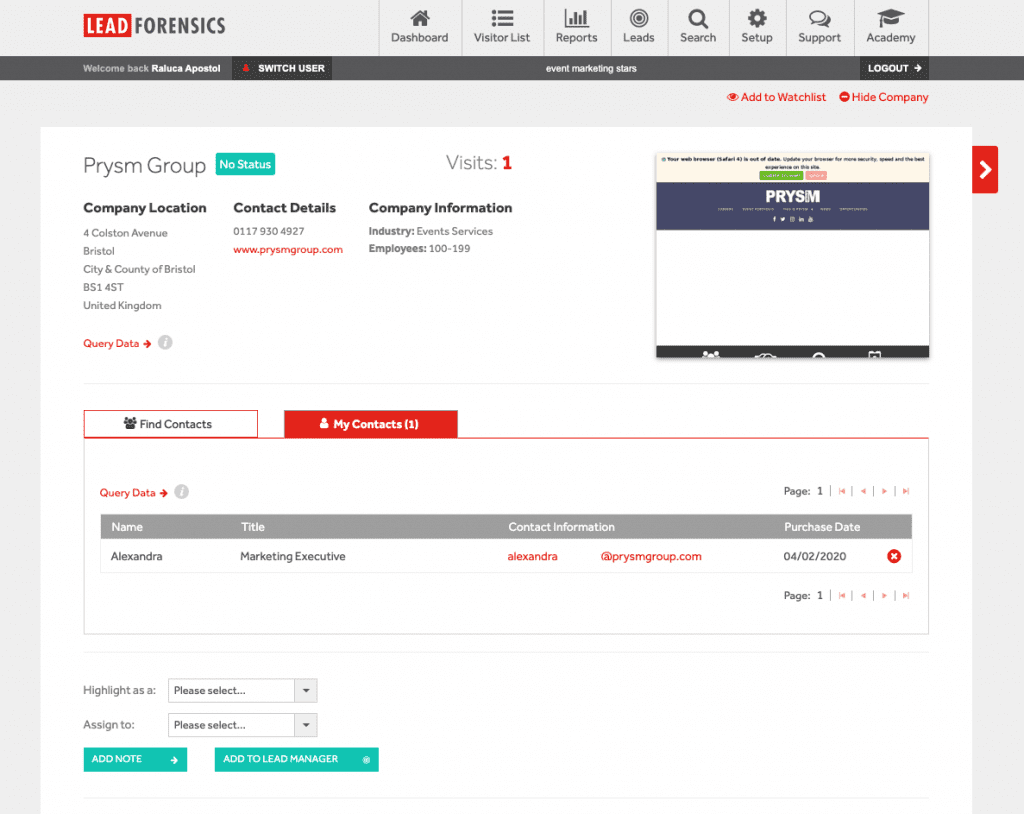
This tools works well with a CRM (although they have a mini version incorporated, by the time you’re using Lead Forensics you should probably have your own). When combining the 2 tools, you know which job titles you should be reaching out to from the companies visiting your website and decide on a follow up plan with them.
Whilst I did mention stalking earlier, please don’t do that, it’s creepy. Go for an introduction from a common connection, remarketing, engage with them in a relevant way on social media, but don’t (and I repeat, DO NOT) call them up and say “hey, you just visited my website, want to talk about our services?”.
Strategy #3: Gain their trust
If you’re reading this, then you want to influence people to buy or even test your services. A strategy you definitely need in order to do this is building thought leadership. 48% of executives say they have done business with a company due to thought leadership (Raconteur) and 83% of buyers say thought leadership builds trust in their organization (LinkedIn).
What you want at this stage is to position your company and employees as the go to resources for know-how in your industry. Like Hubspot is for marketing. There’s no combination of keywords you can search for in Google that won’t return a Hubspot article in the top 10 results (I dare you to find one). If you check any of their articles, you’d see they are mostly about giving valuable info to the visitor, not necessarily about selling their services.
Sure, any good thought leadership strategy generates leads and sales, otherwise we wouldn’t invest the time to do it, but it does this in a smart way. Not in a “look at me, buy my services now” way, not in a “we’ve just connected on LinkedIn and I’ll send you a sales pitch right away”,but in a “I saw you have questions on this and I’ll share what I know from my experience. Hope it helps”. Build their trust and people will want to engage with you in a sales context too, if and when they need the services you offer.
Tools to build and develop thought leadership
- Blog posts, like this one. I didn’t do this to tell you I can help you convert more leads (or it would have been a 100 words post instead of 2,000+), I did it so I can share my know-how on lead conversion, which helps build my authority on it.
- Reports, white papers, infographics or other pieces of complex content you create.
- Networking on social media channels, such as LinkedIn or Twitter or anywhere else you’d find professionals from your industry. Engage in conversations and build your network.
- Networking or speaking at live events, be their your own or those of other companies.
My favourite example of thought leaders are Splash. They do event marketing software and as an event marketer, I’m their target audience. But I didn’t find them when I was looking for a provider (in fact, I’m not even sure what type of software they offer). I found them when I was looking for content, because this is the type of things they put out there:
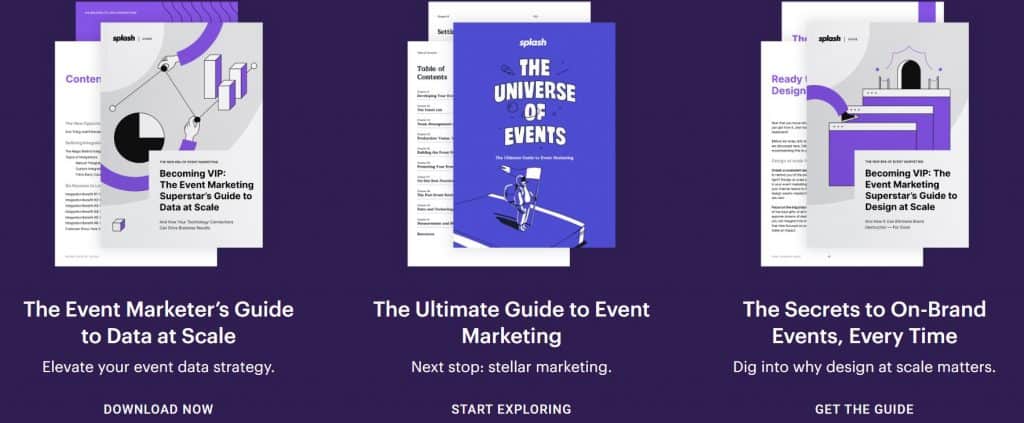
SThe reports they create have interesting info, they have a cool design and they have none or limited promotion about their services in it. While I may not be ready to invest in event marketing software now, they’d definitely be top of my mind when I do get there and that’s what thought leadership helps you achieve.
Strategy #4: Plan the best outreach strategy
From my experience, a lot of lost opportunities come from not engaging with the right contact or in the right way. For example, instead of talking to the Head of Operations, you talk to the IT Director. And in their company, they’re not the decision maker for your services, so they just dismiss your marketing efforts. Or, you tell them about how your product helps them cut costs, but at this point, their main interest is to optimise workforce allocation.
Tool #4: Engage with your audience using social listening tools like Mention (Free for start, Paid version after)
Mention helps you track who is saying what about topics that are interesting to you in your industry or about your services. It can also be used as a customer service tool, but it will help accomplish a different objective. However, you can use it to engage with active users looking for insight or resources you may have.
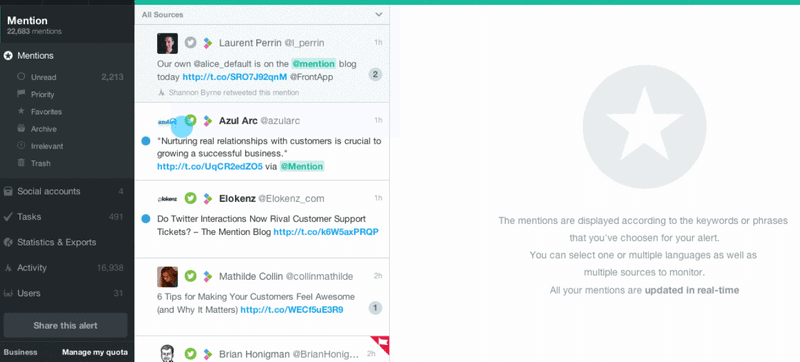
Tool #5: Account Based Marketing software such as Engagio (Paid)
As someone rightly said, ABM is not just a tool, it’s a philosophy. It’s about putting your main clients at the core of your marketing activity and planning a strategy that speaks directly to them and their main needs. This is especially useful for large companies, where you may engage with several contacts in different departments or have complex offering.
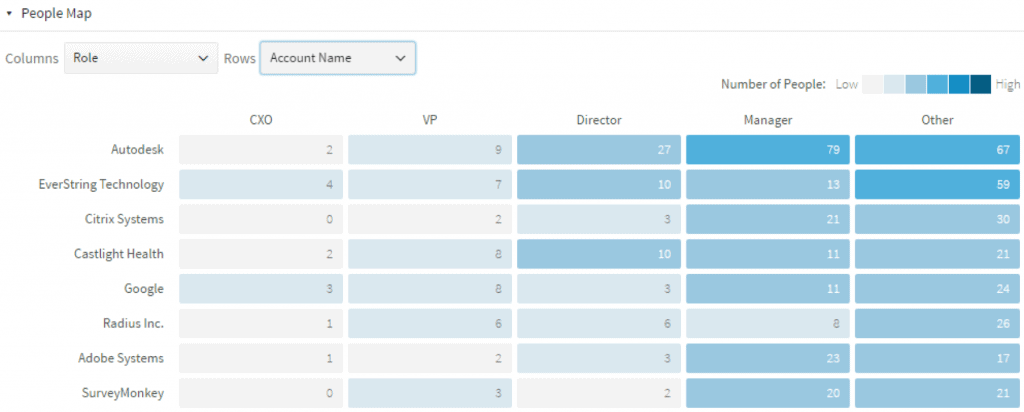
Engagio helps highlight which roles are engaging most with your outreach based on specific companies or industries. It also helps you tailor your marketing to them.
Strategy #5: Only sell when they’re ready
Remember that example from earlier when someone you don’t know sends you an invite on LinkedIn and immediately after you accept goes into pitching? That’s the exact opposite of what you should be doing.
Accepting an invitation on LinkedIn doesn’t show interest in the company’s services and you need to use data to build that insight about the contact. On a scale from 1 to 10, how interested are they in our services and when do we go for the sell? Above 7 or 8 would be my recommendation and you can define what each number means for you. Read more on lead scoring if this doesn’t make sense.
Tools that help you nurture leads
Any tool that tracks interaction and engagement with your company, like all the ones we’ve mentioned in the previous stages. Plus, events can be a good lead nurturing tool, since they’re a great opportunity to showcase know how and network with people. They also give you that extra layer of direct interaction with your leads.
Tool #6: Interact with website visitors with Leadoo (Paid)
Chatbots are becoming increasingly popular because they help us automate and simulate interactions on platforms that have been traditionally static, such as websites. Leadoo can start an in-page conversation with website visitors. This will then help turn the most interested ones in high value leads you can follow up with.
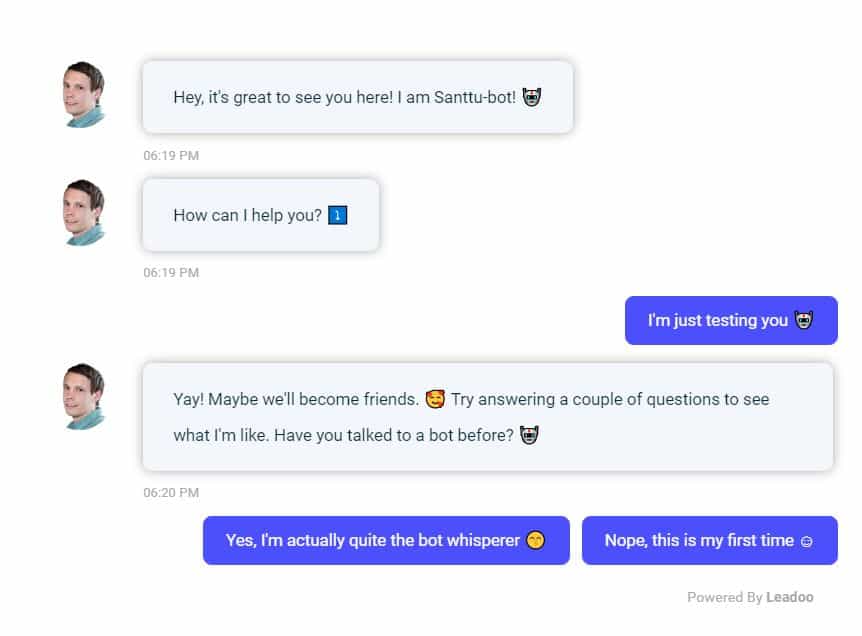
Recap
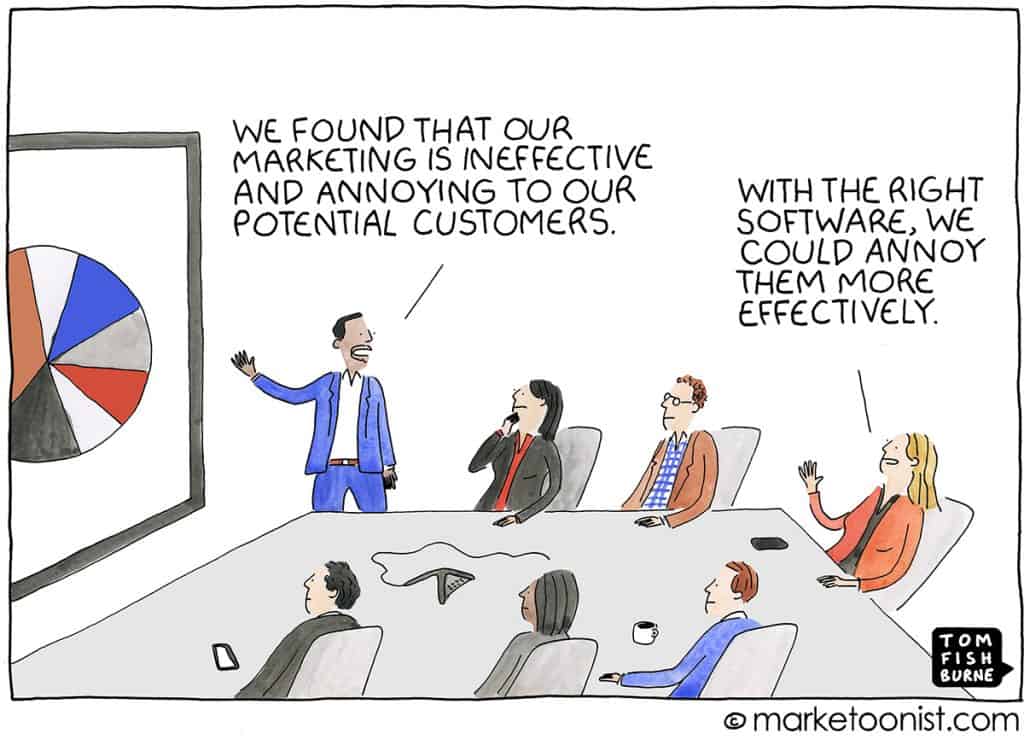
Lead closing is a process. In order to impact it, you need to work on becoming better at every stage of the lead funnel, not just at the end. Before deciding on a new course of action or strategy, work out if it helps you reach your objectives. While new software might look shiny, if you’ve abandoned it after a few months, you’ve only waster your time. Test, analyse and redo until you’ve got it right.
Sign up for the newsletter
Receive the latest articles. No spam, ever.
About the author:

I am Raluca Apostol, Founder and Account Director at Event Marketing Stars and I have helped generate over 30,000 leads for clients in B2B and B2C, on 3 continents.
I am passionate about events, lead generation and monetisation. If you want to reach out, you can find me on LinkedIn here.



Pingback: 5+ strategies and tools that help you convert more leads (short)